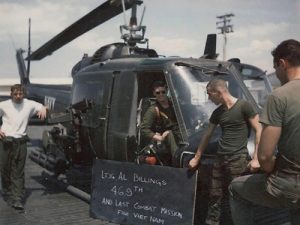Navy Seawolf pilot talks about Vietnam campaigns during next Lunch and Learn – April 24
April 17, 2020Through four tours of Vietnam and 469 combat missions, Al Billings’ superior officers often were torn between taking his wings and giving him a medal.
Billings, a pilot in the U.S. Navy’s Seawolf Detachment helicopter squadron, ultimately was awarded dozens of medals and citations. But he readily admits that there were times when he wound up in hot water after disregarding orders and conducting rescues he was told couldn’t be done. “I know a dozen people alive today who will tell you that it could be done,” he said.
Billings will share his hair-raising combat stories April 24 during the South Carolina Confederate Relic Room and Military Museum’s Lunch and Learn program.
The hour-long session, which will begin at 12:30 p.m., will be conducted with Zoom teleconferencing. You can find the free software here and details about the free event at relicroomsc.com or at the museum’s Facebook page (facebook.com/sccrrmm) The talk is titled “An Objective View of the Vietnam War by a Four-Tour Naval Aviator.” It’s objective, Billings says, because of his distaste for chain-of-command politics.
Billings entered the Navy as an enlisted man after graduating high school, the first in his family to do so. He tried college but the coursework wasn’t clicking. He remembers looking up one day and seeing a formation of A4 Skyhawks flying above. “Being hurled off a platform at 100 mph – that sounded exciting. That’s what I wanted to do.”
He wound up in a helicopter, volunteering for the Seawolf Detachment after he finished flight school. There were only eight men in the class who didn’t have college degrees. “I was hanging on by my fingernails a lot of the time,” Billings recalls.
The Navy’s most-decorated squadron of the Vietnam era and its only helicopter attack squadron, the Seawolves conducted search-and-destroy missions, medical evacuations, reconnaissance and SEAL team insertions. The squadron operated in the populous Mekong Delta of Southern Vietnam, a swampy system of thousands of rivers, canals and streams, as part of Operation Game Warden. The goal was to control what was a vital shipping route for the Viet Cong.
The waterways had few outstanding landmarks for pilots to rely on, and the countryside’s heat and humidity weren’t conducive to peak helicopter performance. The Hueys were frequently underpowered and overloaded, often taking off from converted helipads on World War II-era river patrol boats. And that was during the day. Night operations through the narrow river valleys were even more treacherous.
After his 469th and final mission – the last was in 1973 in Operation End Sweep that cleared harbors of explosives and brought home American Prisoners of War – Billings went on to complete 22 years in the Navy, rising to the rank of commander. He earned a bachelor’s and two master’s degrees along the way.
He eventually settled in his wife’s home state of South Carolina, where he served as information technology director for the state Department of Public Safety before retiring for good.
About the South Carolina Confederate Relic Room and Military Museum
Founded in 1896, the South Carolina Confederate Relic Room and Military Museum is an accredited museum focusing on South Carolina’s distinguished martial tradition through the Revolutionary War, Mexican War, Civil War, Spanish-American War, World War I, World War II, the War on Terror, and other American conflicts. It serves as the state’s military history museum by collecting, preserving, and exhibiting South Carolina’s military material culture from the colonial era to the present, and by providing superior educational experiences and programming. It is located at 301 Gervais St. in Columbia, sharing the Columbia Mills building with the State Museum. For more information, go to https://crr.sc.gov/.
















